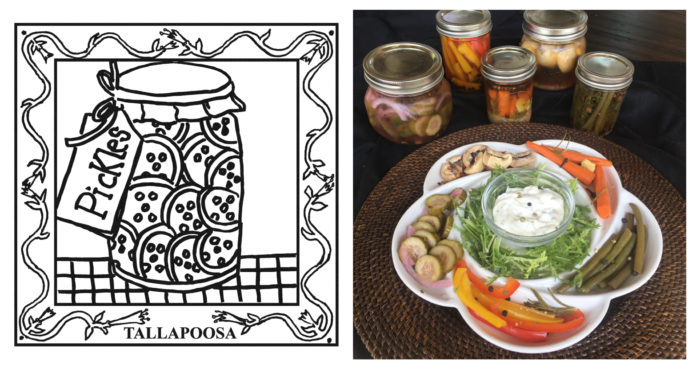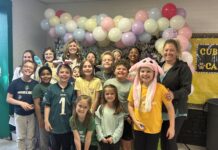
The Cullman Tribune is celebrating the Alabama Bicentennial (1819-2019) with statewide field reporting by Alabama Master Gardener/Botanical Artist Ben Johnson South. This year-long feature, “The 67-County Alabama Garden Party,” will spotlight different counties each week. Each county will get its own “quilt block,” along with a historical profile, and we’ll share a recipe specific to the area. At the end of the year, all 67 counties will be put in a book to commemorate the Bicentennial.
Tallapoosa County
Weaned-on-a-pickle, grumpy, grouchy curmudgeons are rare in Tallapoosa County, but this is indeed Alabama’s “Pickle and Pickling Capital.” Consumer popular, Wickles Pickles, whose products are briskly grabbed off grocery store shelves and foodie pantries in many states, was founded and is still based in Dadeville. Also, the art and science of pickling is taught here every year.
Cucumber pickles first came to America from Spain with Columbus and his sailors, who ate them on their long sea voyages. The first cucumbers planted in our country were grown by the Dutch in New Amsterdam in the 1650s. The word “pickle” comes from the Dutch “pekel” meaning salt or brine. However, cucumbers are native to the Tigris Valley of India. There is evidence of cucumber farming in that part of the world dating back to 2000 BC. The Bible mentions pickles. Shakespeare speaks of pickling. Napoleon Bonaparte supplied his armies with pickles. And, Cleopatra considered pickles to be a beauty secret.
Tallapoosa County was established by European Americans Dec. 18, 1832 after Native Americans, who inhabited this land for centuries in villages along the Coosa River, were forcefully removed. In fact, the last major conflict of the Creek War of 1813-1814 was fought here at the Battle of Horseshoe Bend.
A few months after this historic battle, the Creeks signed a treaty surrendering vast tribal lands to the United States. White settlers rushed to this new frontier to stake land claims for farms and to pan for gold along the banks of the Coosa.
Tallapoosa County settlers in the early part of the 19th century brought pickled cucumbers on their wagons both to sustain them on their journeys and to help them endure through winter. Now, each year, American people, the populace, the public, both plebian and patrician, partake of, pack away, pig-out-on two million pounds of pickles.
Pickles can be made from many plants besides cucumbers: cauliflower, radishes, onions, asparagus, okra and beans. Should you wish to learn more about the process of pickling, Janet Johnson, a food preservation specialist serving the Tallapoosa County office of the Alabama Cooperative Extension System, teaches classes in canning and pickling each year. For class information, call Sallie Mason (as in Mason jar) at 256-825-0848. Actually, Mason jars, the glass containers still popularly used in pickling, were invented in the late-19th century by a tinsmith named John Landis Mason in New Jersey.
While we’re celebrating pickled plant life here in Tallapoosa County it’s a good time to talk about probiotics which are living microorganisms that restore healthy “gut flora” in our bodies and aid in dieting and digestion. Probiotic “good bacteria” help us absorb nutrients and synthesize vitamins.
By eating foods which create healthy “gut flora” rather than harmful, according to Edmond Huang, a metabolic biologist at the University of California, Berkeley, “You may see improvement in diet and digestion in a matter of days or weeks.”
To ingest real food for improving “gut health,” pickles are at the top of the list. Not everything fermented is useful for creating probiotics. For instance, beer, wine and sourdough bread lose their probiotic value in the processes to create them. Nutritionists also recommend these foods for probiotics: plain yogurt, unpasteurized sauerkraut, kimchi, apple cider vinegar, kombucha, miso paste and soft fermented cheeses such as mozzarella and cottage cheese.
A wedding toast I once wrote to a couple in Tallapoosa County was: “May your days be filled with many pickles and your pockets filled with many nickels.”
Here are other positive and pleasurable ways PLANTS + PEOPLE come together in this part of Alabama, including an easy recipe for a variety of refrigerated vegetable “Quickles:”
*MAIN STREET FARMERS MARKET ALEXANDER CITY- 21 Main Street-Broad Street, downtown Alexander City, 34010; Saturdays June1-Sept. 28, 7-11 a.m.
*TALLAPOOSA COUNTY BLUEBERRIES- Blue Haven, 1612 Rainbow Dr., Camp Hill, AL, 334-257-4322; George R. Carlton, 835 Pinecrest Dr., Alexander City, AL 35010
*TALLAPOOSA COUNTY STRAWBERRIES- Sweet Pick’ins Farm, 847 Old Millers Ferry Road, Dadeville, AL 36853, 334-707-8220
*TALLAPOOSA FARMSTANDS- John Neighbors (Alexander City), Pa-Pa’s Produce (Alexander City), Thomas Oliver (Daviston)
*WIND CREEK STATE PARK- This gorgeous 1,445-acre park is one of the largest in the state parks system- 7 miles south of Alexander City on the western side of Lake Martin, a 41,000-acre reservoir on the Tallapoosa River. Known for the best crappie fishing in the Southeast, this large park is also on the Alabama Piedmont Plateau Birding Trail, where you will enjoy a variety of waterfowl, raptors and songbirds. Bald eagles are here throughout the year; also, enjoy the lushly forested hiking trails and be grandly entertained at the Lake Martin Amphitheater.
*LONE OAK FARM- Owned by Dawn and Tim Smith and GPSed at 428 Alabama Highway 120, Notasulga, AL 36866, this U PICK and now WE PICK strawberry farm (end of March and first of April) is an Alabama plant tourist dream. Also, they sell (1/8, 1/4, 1/2 Angus beef); Facebook Lone Oak Farm; www.loneoakfarmal.com; call ahead for seasonal availability, 334-301-6134.
*PLANTING AN IDEA- How about creating The American Pickle Museum in Tallapoosa County, Alabama? Currently, there is only one pickle museum in the world, and it’s a salute to gherkins in Lehde, Germany. The National Mustard Museum in Middleton, Wisconsin has been a popular tourist destination since 1986. The American Pickle Museum would be like Disneyland for those plant tourists who like pickles more than mice. I’m imagining paintings of famous people like Cleopatra and Christopher Columbus (possibly together on her barge or his boat) and Napoleon Bonaparte, who loved pickles. Also, there must be bushels, barrels and vats for tastings. There could be complementary pickles and ice cream for every pregnant museum-goer with a craving. I’m here shamelessly pleading for Shane Harris, prince of a guy, preacher, pickle-enthusiast and coordinator of the Tallapoosa County office of the Alabama Cooperative Extension System to schmooze this idea with the Sims brothers of Wickles Pickles and other pickle-passionate people. There is the deservedly popular Wellborn Muscle Car Museum in Alexander City, and an American Pickle Museum could be popular as well. Please just let the idea ferment awhile.
Y’ALL COME to Tallapoosa County on your 67-County Alabama Garden Party tour! They’ll make you a good dill.
Many thanks to Shane Harris and Sallie Mason of the Tallapoosa County office of the Alabama Cooperative Extension System. Also, thank you to Laurie Johnson who created the colorful, crisp and delish pickled “Quickles.”
Tallapoosa County “Quickles” Sampler (Quick Refrigerator Pickles)
For those of us who are not avid canners, this “pickled anything” recipe is quick and doesn’t need bushels of produce to be worth the effort. Even “quickling” one jar of leftover produce is easy and rewarding. Using a simple fusion of fresh produce, spices and a hot vinegar brine, anyone can create tasty pickles from almost any vegetable or fruit. These are not “canned” in the traditional way, so must be refrigerated, but will keep for a few weeks. They are perfect on a relish or crudité tray or as a spicy bloody mary garnish and they make great gifts. Below is the basic method and my flavor choices for these five samples. Invent and experiment with varied combinations to your heart’s content!
Ingredients for Basic Brine (multiply as needed):
- 1 cup water and 1 cup vinegar – your choice of white, red or rice wine vinegars, flavored or apple cider vinegar (but not aged like balsamic)
- 1 tbsp. each salt and sugar (optional if you don’t want added sugar)
Ingredients – Spice Choices:
- Solid spices – peppercorns, cloves, coriander or dill seeds, pickling spices, red pepper flakes, etc.
- Other flavors like onion, garlic cloves, ginger, lemon or orange peel, etc.
- Firm fresh herbs like thyme, oregano or rosemary twigs
Ingredients – Vegetables or Fruits:
- Almost any fresh and firm vegetable or fruit can be “quickled.” Good choices (in addition to cucumbers) are green beans, asparagus, okra, carrots, peppers, mushrooms, watermelon, peaches, mango, cauliflower, etc.
Instructions:
- Assemble your choice of clean jars with tight-fitting lids. Prep produce to fit the shape and size of the jars; peel if needed and cut into spears, rounds or chunks. Green beans and asparagus may need pre-blanching (2 mins. in boiling water and then cooled in an ice bath).
- Put a tsp. of solid spices, a small amount of the “other flavors” and a sprig or two of the fresh herbs into each jar. Reserve some to drop on top or around the sides later.
- Pack the prepped produce into the jars tightly, leaving a little room at the top.
- Boil the brine quickly to dissolve salt and sugar. (Use multiples of the recipe for what you need.)
- Carefully pour hot brine to fill the jars; punch reserved spices down the sides. Close and cool at room temperature, then keep in the refrigerator. They’ll develop full flavor in a couple of days and should keep, refrigerated, for a couple of weeks until devoured!
My choices of flavors for this five “Quickle” sampler:
- Carrot spears, apple cider vinegar brine, cloves, coriander, ginger, lemon peel and rosemary
- Chunky cut mushrooms, red wine vinegar brine, garlic, red pepper flakes, peppercorns and oregano
- Blanched French green beans, white wine vinegar brine, pickling spices, garlic and thyme sprigs
- Yellow and red bell pepper spears, white wine vinegar brine, peppercorns and rosemary
- Mini cucumber coins, red wine vinegar brine, red onion, pickling spices and oregano
Also, check out Alabama Bicentennial: 200 ways to save Alabama for the next 200 years.
Copyright 2019 Humble Roots, LLC. All Rights Reserved.
























